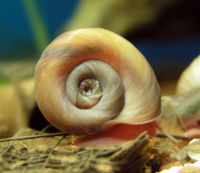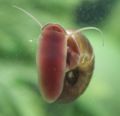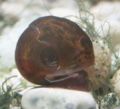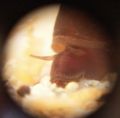Ramshorn Snail (Gyraulus sp.)
From The Aquarium Wiki
(Redirected from Ramshorn Snail)
Ramshorn Snail
Gyraulus sp.
8 Litres (2 US G.)
2.5-5.1cm (1-2 ")
Freshwater
7.0 - 8.0
17.8-30°C (64 -86 °F)
8-18 °d
1-2 years
This animal is available captive bred
Contents
About Ramshorn Snails[edit]
- Ramshorn snails are a group of invertebrate snails commonly found in freshwater aquarium tanks. They are commonly brought in on live plants. These scavengers provide a useful function of breaking down decaying plant and animals. They also eat algae.
Alternative names[edit]
- Red Ramshorn, Brown Ramshorn, Wheel Snails, Ear Snails.
Species[edit]
- Any snail of the family Planorbidae (Gyraulus sp. etc.) can be classified as a ramshorn. Many people also include the species Marisa cornuarietis, or Colombian ramshorn, as a ramshorn snail, but this species has many differences from the common ramshorn.
Sexing[edit]
- Hermaphrodites. As any two members regardless of sex can reproduce, they will produce a great many offspring.
Breeding[edit]
- A ramshorn will normally start reproducing within 4 weeks of being born if well fed. It lays a small gelatin like patch of eggs on any surface. After 10-20 days (depending on temperature) these will hatch. The babies of red ramshorn are very tiny but identical to their parents. They will be able to find their own food in the tank.
Tank compatibility[edit]
- Will mix with virtually any other non-predator aquatic animal. Do not keep with Loaches, Pufferfish, or other creatures that eat snails.
Diet[edit]
- Gyraulus sp. will eat algae, detritus, and parboiled or raw vegetables. They will eat catfish wafers and fish flakes if fed correctly.
Feeding regime[edit]
Ramshorns typically sustain themselves on algae, decaying plants, and excess food which falls to the bottom of the tank. They will also consume dead fish. Depending on the environment, calcium supplementation may be necessary to prevent shell damage.
Environment Specifics[edit]
- Must have calcium (hardness, GH) in the water and a pH greater than 7.0 or the shell will dissolve and the snail will die. A tank with algae present in beneficial to the snail as it acts as good grazing.
- Does not like salt.
Behavior[edit]
- This snail is a slow roamer and will explore all over the aquarium, keeping under the water. The snail can not control its own internal temperature, so if it is kept at the higher temperature it will move around more quickly, but will have a shorter life span of about a year. This snail does not have gills, and must occasionally come up to the surface to breathe air; therefore, it can often be seen attached to the underside of the surface of the water.
- It has been noticed that these snails prefer to sit upon black or dark surfaces. They often clump together on the glass sealant if it is black or on a internal filter.
- They can also be an indicator of water quality. A number of the snails climbing out of the water is a good indication of excess ammonia or nitrite being present.
Identification[edit]
- This name covers a range of species. They are called 'ramshorn' due to their shell resembling tightly coiled horns of some sheep.
- Ramshorns come in a variety of colours: dark brown, black, blue, beige, red and other shades in between.
Special Notes[edit]
- The condition of its shell shows the history of its life. So if purchasing one, look carefully at its shell. Patches of white indicates shell damage due to calcium deficiency.
- It is important to note that ramshorn snails are able to carry various parasitic flukes, which can be transmitted to fish or humans. Most of these flukes require intermediate hosts, so that leaving the snails by themselves for a month or so will eliminate the disease.
Removing Ramshorns[edit]
- Some aquarists do not like the ramshorn due to certain varieties (brown or ear snails) eating holes in their plant leaves. However, they usually only attack plants when the plants are weak or decaying. An ample food source will typically prevent them from attacking plants.
- There are several methods of removing snails:
- Adding a chemical into the water that kills them.
- There are a range of commercial liquids available which claim to kill snails. Be careful reading the products as most just stun them or cause them to come to the surface for a time. Copper will kill them.
- Adding a chemical into the water that stuns them.
- There are a range of commercial liquids available which claim to stun snails.
- Be careful as a lot of dead snails in your tank will lead to dangerous ammonia production as the flesh decays and algae will grow.
- Manually removing the snails.
- Simply remove the young snails as they approach the surface when feeding. Alternatively squash the snails against the glass with your finger tip. Small fish like Minnows and Tetras will welcome any squashed snails and can quickly learn that your fingers in the tank can be a source of food and so become tame waiting for you to give them a treat!
- Baiting a trap and removing them.
- There are several commercial snail traps available. (See JBL Snail trap review). These you bait at night and the snails crawl in and can't get out. So in the morning you simply remove the trap. Simple to make your own too.
- Add an animal that will eat them.
- Most loaches will eat small ear snails (young ramshorns). Whilst the Clown Loach is the most often quoted as doing this function it can grow quite large. If you want a smaller fish there are several species of loaches (like the Zebra Loach, Pakistan loach (Yo Yo)) that remain under 4" in length and will eat the young snails. Puffers like the freshwater Ceylon Puffer will eat any type of snail once it grows bigger enough.
Preventing ramshorns from entering your tank[edit]
- You need to soak all objects and plants with a snail killing chemical before adding to your tank. One such popular and cheap chemical for doing this is Potassium Permanganate.
- If you are wary of using chemicals, be sure to carefully examine new items for your tank for the tell-tale jelly-like egg sacks and remove by hand. If possible, avoiding buying décor or plants when the snails are clearly present in the tank.






